HC3031 Trends in Global Business Environment: Literature Review Report
VerifiedAdded on 2022/12/27
|9
|2024
|89
Report
AI Summary
This report presents a literature review exploring new trends in the global business environment, focusing on the next 50 years. It examines the role of technology in shaping future business and revenue models, addressing key questions impacting industries. The review discusses the potential impact of automation on employment, government-private sector collaborations, demographic shifts, and the rise of emerging markets like India and China. The report also analyzes differing perspectives on globalization, the emergence of a new middle class, and the potential for economic downturns. The author reviews both promotional and peer-reviewed literature, highlighting the challenges of globalization and the need for sustainable business strategies.

1
Paraphrase This Document
Need a fresh take? Get an instant paraphrase of this document with our AI Paraphraser
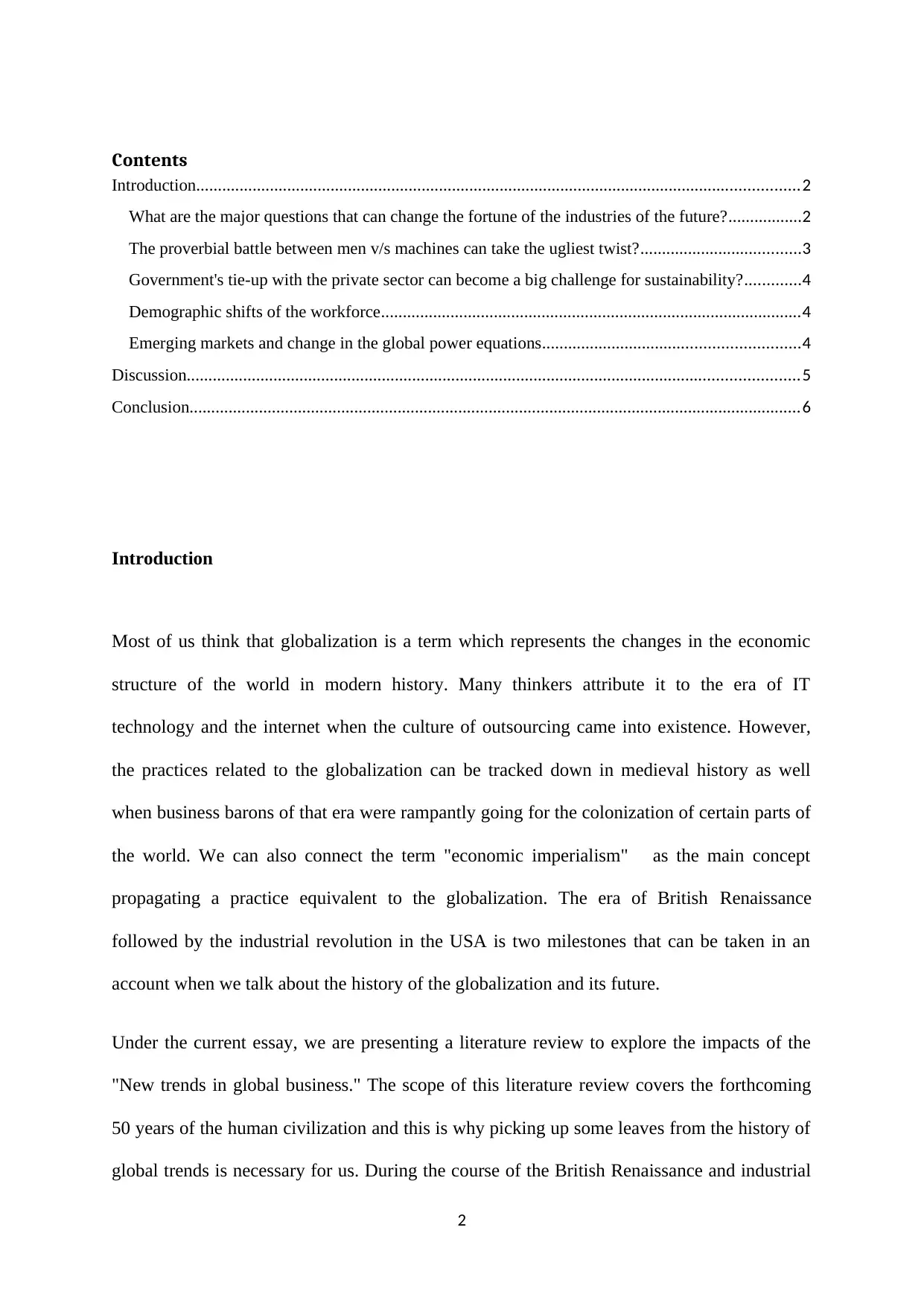
Contents
Introduction...........................................................................................................................................2
What are the major questions that can change the fortune of the industries of the future?.................2
The proverbial battle between men v/s machines can take the ugliest twist?.....................................3
Government's tie-up with the private sector can become a big challenge for sustainability?.............4
Demographic shifts of the workforce.................................................................................................4
Emerging markets and change in the global power equations...........................................................4
Discussion.............................................................................................................................................5
Conclusion.............................................................................................................................................6
Introduction
Most of us think that globalization is a term which represents the changes in the economic
structure of the world in modern history. Many thinkers attribute it to the era of IT
technology and the internet when the culture of outsourcing came into existence. However,
the practices related to the globalization can be tracked down in medieval history as well
when business barons of that era were rampantly going for the colonization of certain parts of
the world. We can also connect the term "economic imperialism" as the main concept
propagating a practice equivalent to the globalization. The era of British Renaissance
followed by the industrial revolution in the USA is two milestones that can be taken in an
account when we talk about the history of the globalization and its future.
Under the current essay, we are presenting a literature review to explore the impacts of the
"New trends in global business." The scope of this literature review covers the forthcoming
50 years of the human civilization and this is why picking up some leaves from the history of
global trends is necessary for us. During the course of the British Renaissance and industrial
2
Introduction...........................................................................................................................................2
What are the major questions that can change the fortune of the industries of the future?.................2
The proverbial battle between men v/s machines can take the ugliest twist?.....................................3
Government's tie-up with the private sector can become a big challenge for sustainability?.............4
Demographic shifts of the workforce.................................................................................................4
Emerging markets and change in the global power equations...........................................................4
Discussion.............................................................................................................................................5
Conclusion.............................................................................................................................................6
Introduction
Most of us think that globalization is a term which represents the changes in the economic
structure of the world in modern history. Many thinkers attribute it to the era of IT
technology and the internet when the culture of outsourcing came into existence. However,
the practices related to the globalization can be tracked down in medieval history as well
when business barons of that era were rampantly going for the colonization of certain parts of
the world. We can also connect the term "economic imperialism" as the main concept
propagating a practice equivalent to the globalization. The era of British Renaissance
followed by the industrial revolution in the USA is two milestones that can be taken in an
account when we talk about the history of the globalization and its future.
Under the current essay, we are presenting a literature review to explore the impacts of the
"New trends in global business." The scope of this literature review covers the forthcoming
50 years of the human civilization and this is why picking up some leaves from the history of
global trends is necessary for us. During the course of the British Renaissance and industrial
2
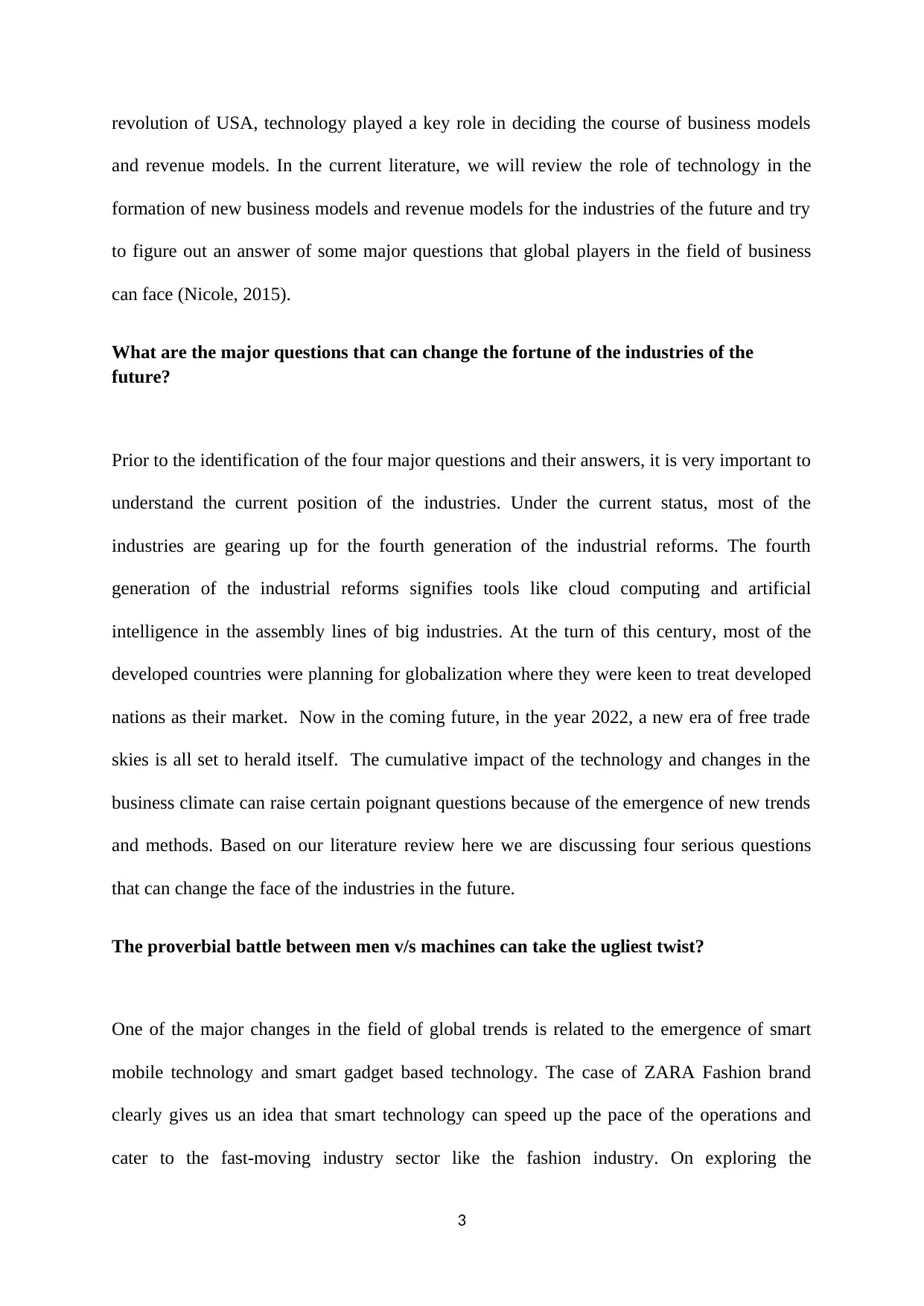
revolution of USA, technology played a key role in deciding the course of business models
and revenue models. In the current literature, we will review the role of technology in the
formation of new business models and revenue models for the industries of the future and try
to figure out an answer of some major questions that global players in the field of business
can face (Nicole, 2015).
What are the major questions that can change the fortune of the industries of the
future?
Prior to the identification of the four major questions and their answers, it is very important to
understand the current position of the industries. Under the current status, most of the
industries are gearing up for the fourth generation of the industrial reforms. The fourth
generation of the industrial reforms signifies tools like cloud computing and artificial
intelligence in the assembly lines of big industries. At the turn of this century, most of the
developed countries were planning for globalization where they were keen to treat developed
nations as their market. Now in the coming future, in the year 2022, a new era of free trade
skies is all set to herald itself. The cumulative impact of the technology and changes in the
business climate can raise certain poignant questions because of the emergence of new trends
and methods. Based on our literature review here we are discussing four serious questions
that can change the face of the industries in the future.
The proverbial battle between men v/s machines can take the ugliest twist?
One of the major changes in the field of global trends is related to the emergence of smart
mobile technology and smart gadget based technology. The case of ZARA Fashion brand
clearly gives us an idea that smart technology can speed up the pace of the operations and
cater to the fast-moving industry sector like the fashion industry. On exploring the
3
and revenue models. In the current literature, we will review the role of technology in the
formation of new business models and revenue models for the industries of the future and try
to figure out an answer of some major questions that global players in the field of business
can face (Nicole, 2015).
What are the major questions that can change the fortune of the industries of the
future?
Prior to the identification of the four major questions and their answers, it is very important to
understand the current position of the industries. Under the current status, most of the
industries are gearing up for the fourth generation of the industrial reforms. The fourth
generation of the industrial reforms signifies tools like cloud computing and artificial
intelligence in the assembly lines of big industries. At the turn of this century, most of the
developed countries were planning for globalization where they were keen to treat developed
nations as their market. Now in the coming future, in the year 2022, a new era of free trade
skies is all set to herald itself. The cumulative impact of the technology and changes in the
business climate can raise certain poignant questions because of the emergence of new trends
and methods. Based on our literature review here we are discussing four serious questions
that can change the face of the industries in the future.
The proverbial battle between men v/s machines can take the ugliest twist?
One of the major changes in the field of global trends is related to the emergence of smart
mobile technology and smart gadget based technology. The case of ZARA Fashion brand
clearly gives us an idea that smart technology can speed up the pace of the operations and
cater to the fast-moving industry sector like the fashion industry. On exploring the
3
⊘ This is a preview!⊘
Do you want full access?
Subscribe today to unlock all pages.

Trusted by 1+ million students worldwide
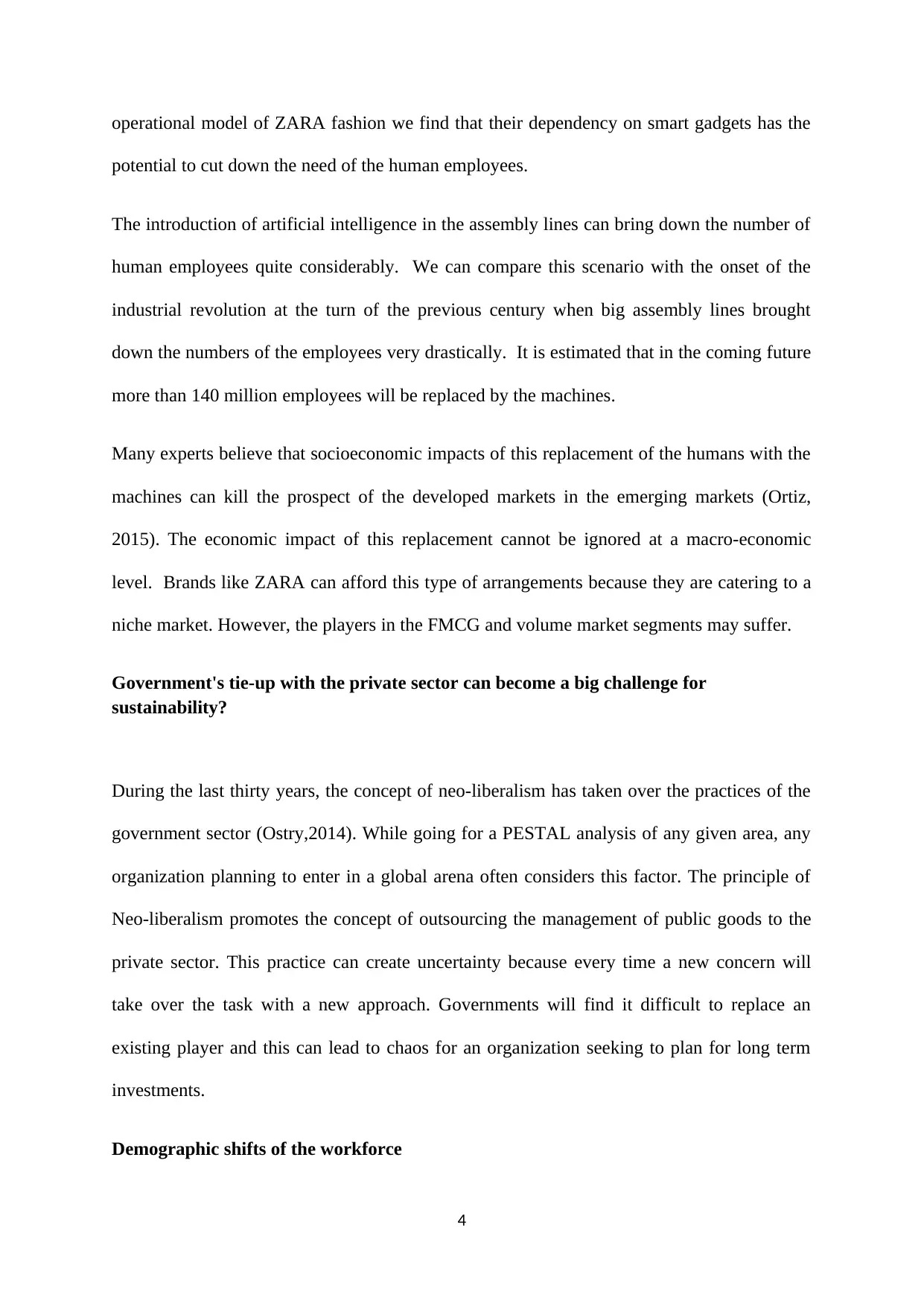
operational model of ZARA fashion we find that their dependency on smart gadgets has the
potential to cut down the need of the human employees.
The introduction of artificial intelligence in the assembly lines can bring down the number of
human employees quite considerably. We can compare this scenario with the onset of the
industrial revolution at the turn of the previous century when big assembly lines brought
down the numbers of the employees very drastically. It is estimated that in the coming future
more than 140 million employees will be replaced by the machines.
Many experts believe that socioeconomic impacts of this replacement of the humans with the
machines can kill the prospect of the developed markets in the emerging markets (Ortiz,
2015). The economic impact of this replacement cannot be ignored at a macro-economic
level. Brands like ZARA can afford this type of arrangements because they are catering to a
niche market. However, the players in the FMCG and volume market segments may suffer.
Government's tie-up with the private sector can become a big challenge for
sustainability?
During the last thirty years, the concept of neo-liberalism has taken over the practices of the
government sector (Ostry,2014). While going for a PESTAL analysis of any given area, any
organization planning to enter in a global arena often considers this factor. The principle of
Neo-liberalism promotes the concept of outsourcing the management of public goods to the
private sector. This practice can create uncertainty because every time a new concern will
take over the task with a new approach. Governments will find it difficult to replace an
existing player and this can lead to chaos for an organization seeking to plan for long term
investments.
Demographic shifts of the workforce
4
potential to cut down the need of the human employees.
The introduction of artificial intelligence in the assembly lines can bring down the number of
human employees quite considerably. We can compare this scenario with the onset of the
industrial revolution at the turn of the previous century when big assembly lines brought
down the numbers of the employees very drastically. It is estimated that in the coming future
more than 140 million employees will be replaced by the machines.
Many experts believe that socioeconomic impacts of this replacement of the humans with the
machines can kill the prospect of the developed markets in the emerging markets (Ortiz,
2015). The economic impact of this replacement cannot be ignored at a macro-economic
level. Brands like ZARA can afford this type of arrangements because they are catering to a
niche market. However, the players in the FMCG and volume market segments may suffer.
Government's tie-up with the private sector can become a big challenge for
sustainability?
During the last thirty years, the concept of neo-liberalism has taken over the practices of the
government sector (Ostry,2014). While going for a PESTAL analysis of any given area, any
organization planning to enter in a global arena often considers this factor. The principle of
Neo-liberalism promotes the concept of outsourcing the management of public goods to the
private sector. This practice can create uncertainty because every time a new concern will
take over the task with a new approach. Governments will find it difficult to replace an
existing player and this can lead to chaos for an organization seeking to plan for long term
investments.
Demographic shifts of the workforce
4
Paraphrase This Document
Need a fresh take? Get an instant paraphrase of this document with our AI Paraphraser
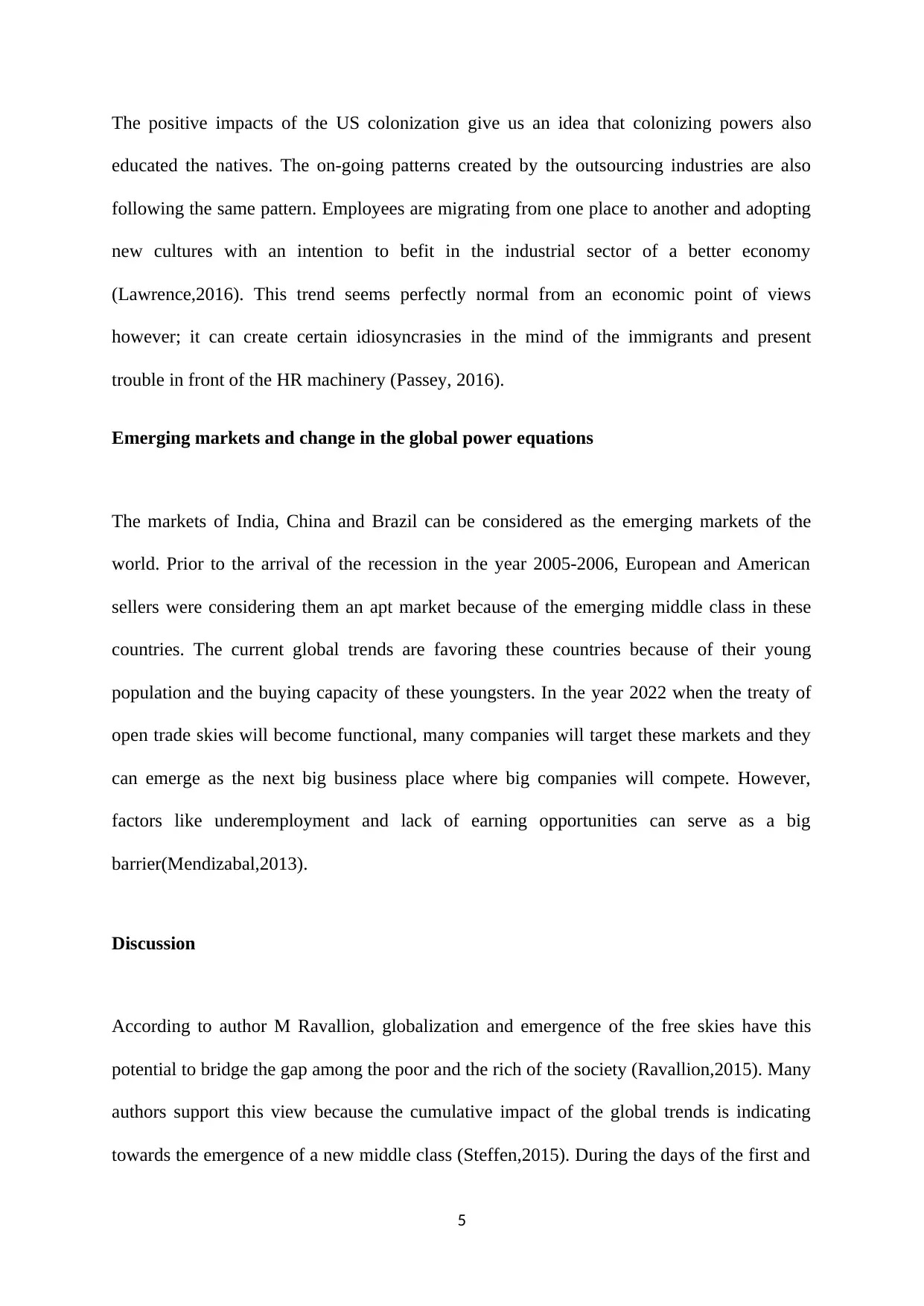
The positive impacts of the US colonization give us an idea that colonizing powers also
educated the natives. The on-going patterns created by the outsourcing industries are also
following the same pattern. Employees are migrating from one place to another and adopting
new cultures with an intention to befit in the industrial sector of a better economy
(Lawrence,2016). This trend seems perfectly normal from an economic point of views
however; it can create certain idiosyncrasies in the mind of the immigrants and present
trouble in front of the HR machinery (Passey, 2016).
Emerging markets and change in the global power equations
The markets of India, China and Brazil can be considered as the emerging markets of the
world. Prior to the arrival of the recession in the year 2005-2006, European and American
sellers were considering them an apt market because of the emerging middle class in these
countries. The current global trends are favoring these countries because of their young
population and the buying capacity of these youngsters. In the year 2022 when the treaty of
open trade skies will become functional, many companies will target these markets and they
can emerge as the next big business place where big companies will compete. However,
factors like underemployment and lack of earning opportunities can serve as a big
barrier(Mendizabal,2013).
Discussion
According to author M Ravallion, globalization and emergence of the free skies have this
potential to bridge the gap among the poor and the rich of the society (Ravallion,2015). Many
authors support this view because the cumulative impact of the global trends is indicating
towards the emergence of a new middle class (Steffen,2015). During the days of the first and
5
educated the natives. The on-going patterns created by the outsourcing industries are also
following the same pattern. Employees are migrating from one place to another and adopting
new cultures with an intention to befit in the industrial sector of a better economy
(Lawrence,2016). This trend seems perfectly normal from an economic point of views
however; it can create certain idiosyncrasies in the mind of the immigrants and present
trouble in front of the HR machinery (Passey, 2016).
Emerging markets and change in the global power equations
The markets of India, China and Brazil can be considered as the emerging markets of the
world. Prior to the arrival of the recession in the year 2005-2006, European and American
sellers were considering them an apt market because of the emerging middle class in these
countries. The current global trends are favoring these countries because of their young
population and the buying capacity of these youngsters. In the year 2022 when the treaty of
open trade skies will become functional, many companies will target these markets and they
can emerge as the next big business place where big companies will compete. However,
factors like underemployment and lack of earning opportunities can serve as a big
barrier(Mendizabal,2013).
Discussion
According to author M Ravallion, globalization and emergence of the free skies have this
potential to bridge the gap among the poor and the rich of the society (Ravallion,2015). Many
authors support this view because the cumulative impact of the global trends is indicating
towards the emergence of a new middle class (Steffen,2015). During the days of the first and
5
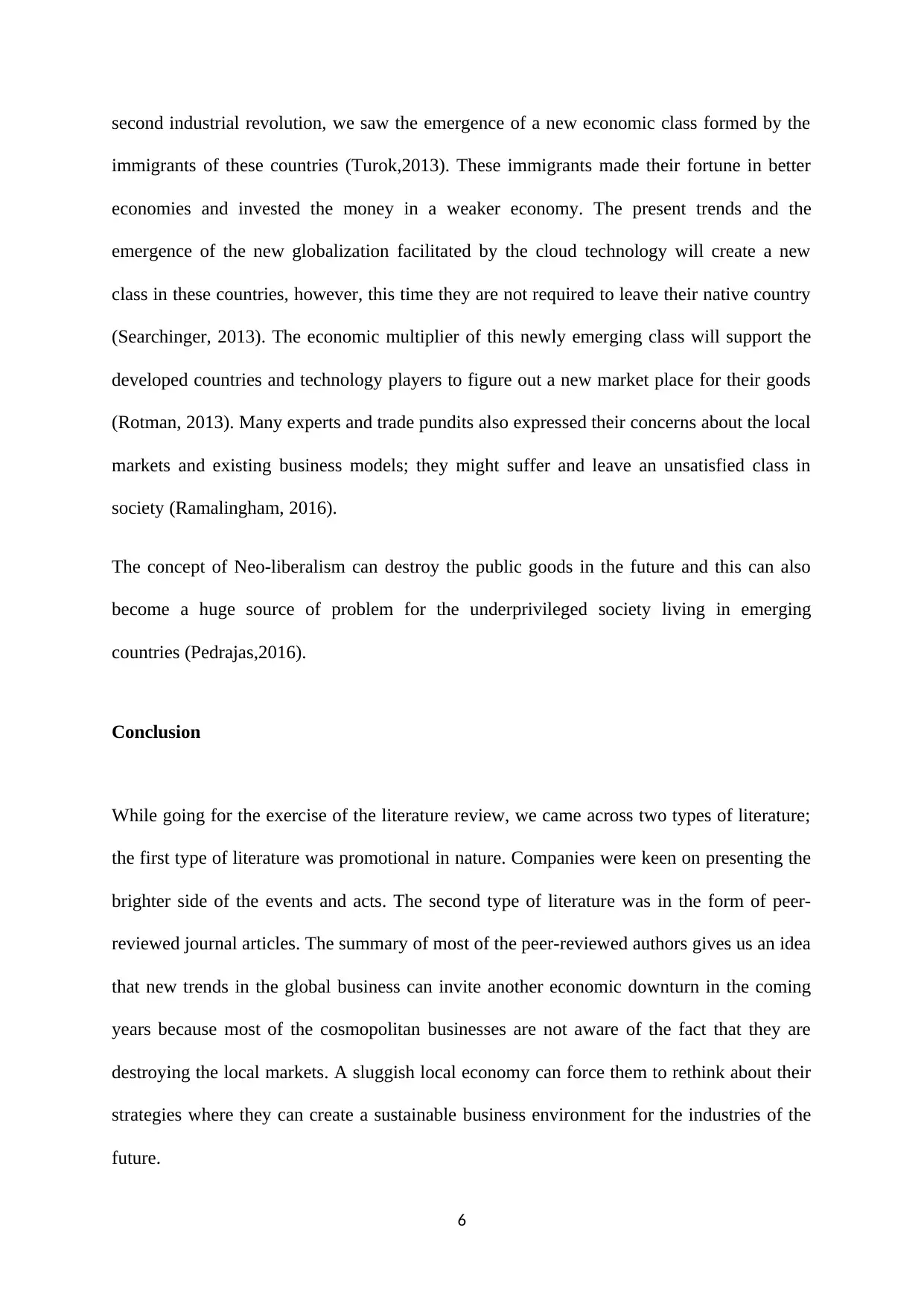
second industrial revolution, we saw the emergence of a new economic class formed by the
immigrants of these countries (Turok,2013). These immigrants made their fortune in better
economies and invested the money in a weaker economy. The present trends and the
emergence of the new globalization facilitated by the cloud technology will create a new
class in these countries, however, this time they are not required to leave their native country
(Searchinger, 2013). The economic multiplier of this newly emerging class will support the
developed countries and technology players to figure out a new market place for their goods
(Rotman, 2013). Many experts and trade pundits also expressed their concerns about the local
markets and existing business models; they might suffer and leave an unsatisfied class in
society (Ramalingham, 2016).
The concept of Neo-liberalism can destroy the public goods in the future and this can also
become a huge source of problem for the underprivileged society living in emerging
countries (Pedrajas,2016).
Conclusion
While going for the exercise of the literature review, we came across two types of literature;
the first type of literature was promotional in nature. Companies were keen on presenting the
brighter side of the events and acts. The second type of literature was in the form of peer-
reviewed journal articles. The summary of most of the peer-reviewed authors gives us an idea
that new trends in the global business can invite another economic downturn in the coming
years because most of the cosmopolitan businesses are not aware of the fact that they are
destroying the local markets. A sluggish local economy can force them to rethink about their
strategies where they can create a sustainable business environment for the industries of the
future.
6
immigrants of these countries (Turok,2013). These immigrants made their fortune in better
economies and invested the money in a weaker economy. The present trends and the
emergence of the new globalization facilitated by the cloud technology will create a new
class in these countries, however, this time they are not required to leave their native country
(Searchinger, 2013). The economic multiplier of this newly emerging class will support the
developed countries and technology players to figure out a new market place for their goods
(Rotman, 2013). Many experts and trade pundits also expressed their concerns about the local
markets and existing business models; they might suffer and leave an unsatisfied class in
society (Ramalingham, 2016).
The concept of Neo-liberalism can destroy the public goods in the future and this can also
become a huge source of problem for the underprivileged society living in emerging
countries (Pedrajas,2016).
Conclusion
While going for the exercise of the literature review, we came across two types of literature;
the first type of literature was promotional in nature. Companies were keen on presenting the
brighter side of the events and acts. The second type of literature was in the form of peer-
reviewed journal articles. The summary of most of the peer-reviewed authors gives us an idea
that new trends in the global business can invite another economic downturn in the coming
years because most of the cosmopolitan businesses are not aware of the fact that they are
destroying the local markets. A sluggish local economy can force them to rethink about their
strategies where they can create a sustainable business environment for the industries of the
future.
6
⊘ This is a preview!⊘
Do you want full access?
Subscribe today to unlock all pages.

Trusted by 1+ million students worldwide

7
Paraphrase This Document
Need a fresh take? Get an instant paraphrase of this document with our AI Paraphraser
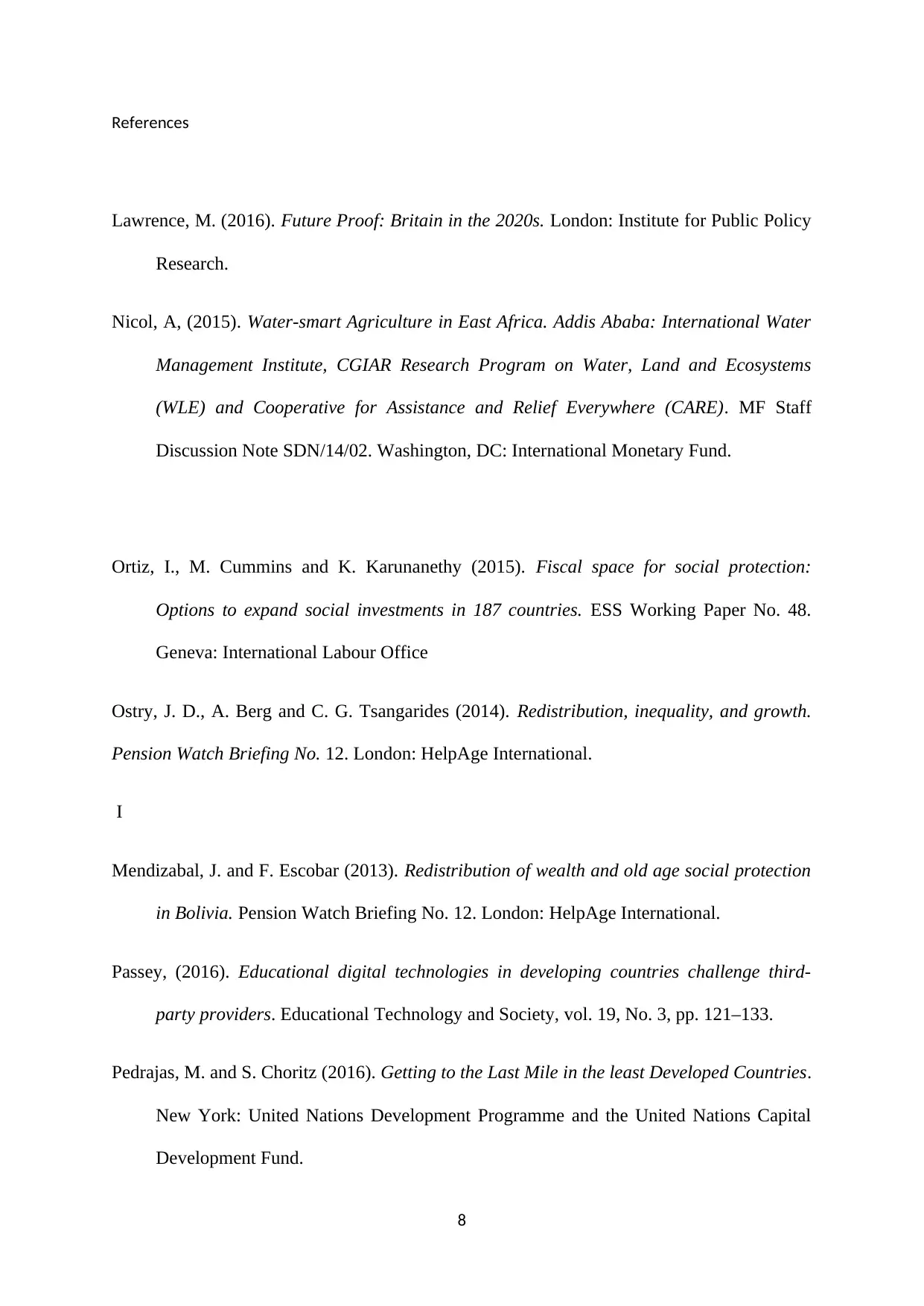
References
Lawrence, M. (2016). Future Proof: Britain in the 2020s. London: Institute for Public Policy
Research.
Nicol, A, (2015). Water-smart Agriculture in East Africa. Addis Ababa: International Water
Management Institute, CGIAR Research Program on Water, Land and Ecosystems
(WLE) and Cooperative for Assistance and Relief Everywhere (CARE). MF Staff
Discussion Note SDN/14/02. Washington, DC: International Monetary Fund.
Ortiz, I., M. Cummins and K. Karunanethy (2015). Fiscal space for social protection:
Options to expand social investments in 187 countries. ESS Working Paper No. 48.
Geneva: International Labour Office
Ostry, J. D., A. Berg and C. G. Tsangarides (2014). Redistribution, inequality, and growth.
Pension Watch Briefing No. 12. London: HelpAge International.
I
Mendizabal, J. and F. Escobar (2013). Redistribution of wealth and old age social protection
in Bolivia. Pension Watch Briefing No. 12. London: HelpAge International.
Passey, (2016). Educational digital technologies in developing countries challenge third-
party providers. Educational Technology and Society, vol. 19, No. 3, pp. 121–133.
Pedrajas, M. and S. Choritz (2016). Getting to the Last Mile in the least Developed Countries.
New York: United Nations Development Programme and the United Nations Capital
Development Fund.
8
Lawrence, M. (2016). Future Proof: Britain in the 2020s. London: Institute for Public Policy
Research.
Nicol, A, (2015). Water-smart Agriculture in East Africa. Addis Ababa: International Water
Management Institute, CGIAR Research Program on Water, Land and Ecosystems
(WLE) and Cooperative for Assistance and Relief Everywhere (CARE). MF Staff
Discussion Note SDN/14/02. Washington, DC: International Monetary Fund.
Ortiz, I., M. Cummins and K. Karunanethy (2015). Fiscal space for social protection:
Options to expand social investments in 187 countries. ESS Working Paper No. 48.
Geneva: International Labour Office
Ostry, J. D., A. Berg and C. G. Tsangarides (2014). Redistribution, inequality, and growth.
Pension Watch Briefing No. 12. London: HelpAge International.
I
Mendizabal, J. and F. Escobar (2013). Redistribution of wealth and old age social protection
in Bolivia. Pension Watch Briefing No. 12. London: HelpAge International.
Passey, (2016). Educational digital technologies in developing countries challenge third-
party providers. Educational Technology and Society, vol. 19, No. 3, pp. 121–133.
Pedrajas, M. and S. Choritz (2016). Getting to the Last Mile in the least Developed Countries.
New York: United Nations Development Programme and the United Nations Capital
Development Fund.
8
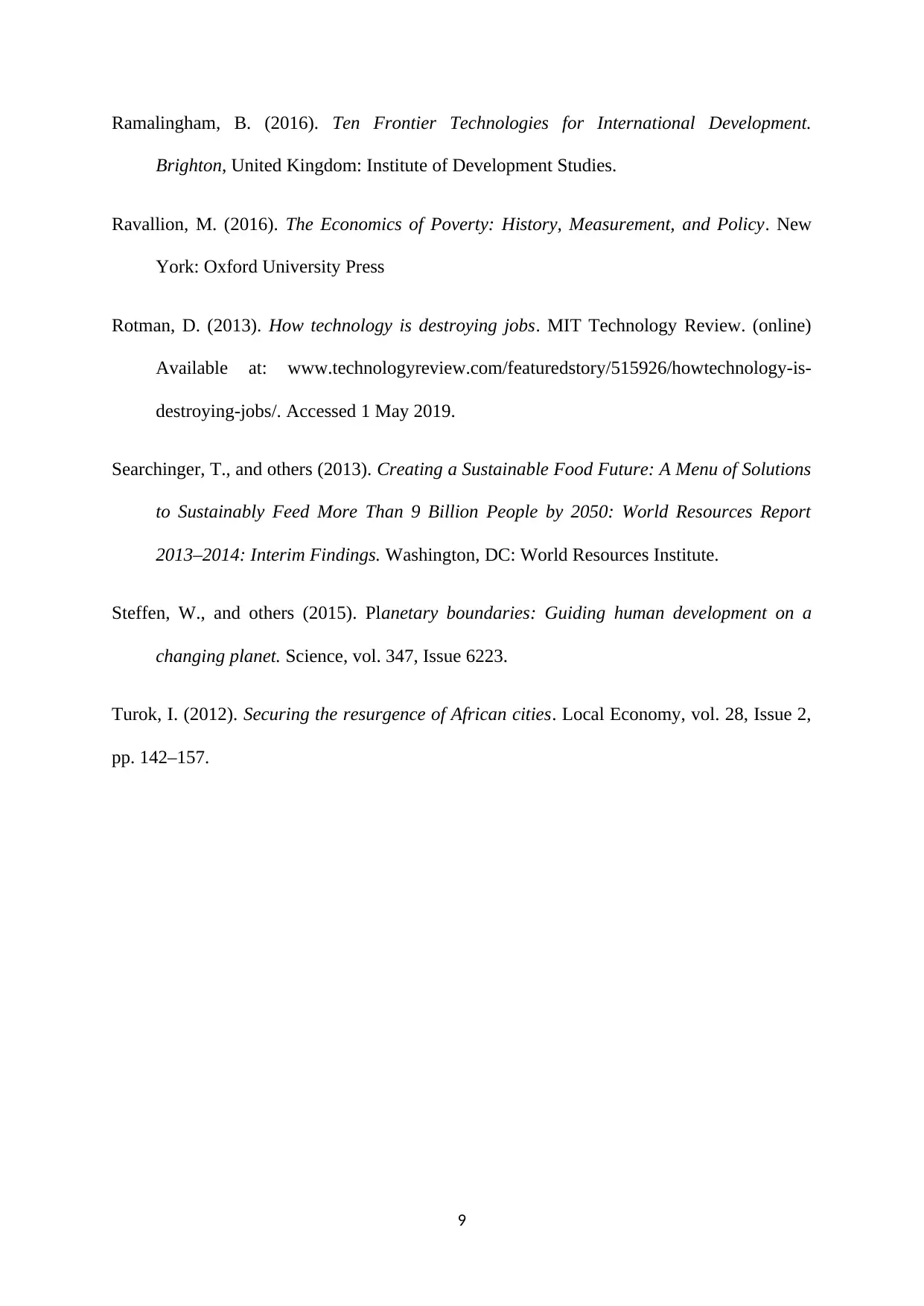
Ramalingham, B. (2016). Ten Frontier Technologies for International Development.
Brighton, United Kingdom: Institute of Development Studies.
Ravallion, M. (2016). The Economics of Poverty: History, Measurement, and Policy. New
York: Oxford University Press
Rotman, D. (2013). How technology is destroying jobs. MIT Technology Review. (online)
Available at: www.technologyreview.com/featuredstory/515926/howtechnology-is-
destroying-jobs/. Accessed 1 May 2019.
Searchinger, T., and others (2013). Creating a Sustainable Food Future: A Menu of Solutions
to Sustainably Feed More Than 9 Billion People by 2050: World Resources Report
2013–2014: Interim Findings. Washington, DC: World Resources Institute.
Steffen, W., and others (2015). Planetary boundaries: Guiding human development on a
changing planet. Science, vol. 347, Issue 6223.
Turok, I. (2012). Securing the resurgence of African cities. Local Economy, vol. 28, Issue 2,
pp. 142–157.
9
Brighton, United Kingdom: Institute of Development Studies.
Ravallion, M. (2016). The Economics of Poverty: History, Measurement, and Policy. New
York: Oxford University Press
Rotman, D. (2013). How technology is destroying jobs. MIT Technology Review. (online)
Available at: www.technologyreview.com/featuredstory/515926/howtechnology-is-
destroying-jobs/. Accessed 1 May 2019.
Searchinger, T., and others (2013). Creating a Sustainable Food Future: A Menu of Solutions
to Sustainably Feed More Than 9 Billion People by 2050: World Resources Report
2013–2014: Interim Findings. Washington, DC: World Resources Institute.
Steffen, W., and others (2015). Planetary boundaries: Guiding human development on a
changing planet. Science, vol. 347, Issue 6223.
Turok, I. (2012). Securing the resurgence of African cities. Local Economy, vol. 28, Issue 2,
pp. 142–157.
9
⊘ This is a preview!⊘
Do you want full access?
Subscribe today to unlock all pages.

Trusted by 1+ million students worldwide
1 out of 9
Related Documents
Your All-in-One AI-Powered Toolkit for Academic Success.
+13062052269
info@desklib.com
Available 24*7 on WhatsApp / Email
![[object Object]](/_next/static/media/star-bottom.7253800d.svg)
Unlock your academic potential
Copyright © 2020–2025 A2Z Services. All Rights Reserved. Developed and managed by ZUCOL.




